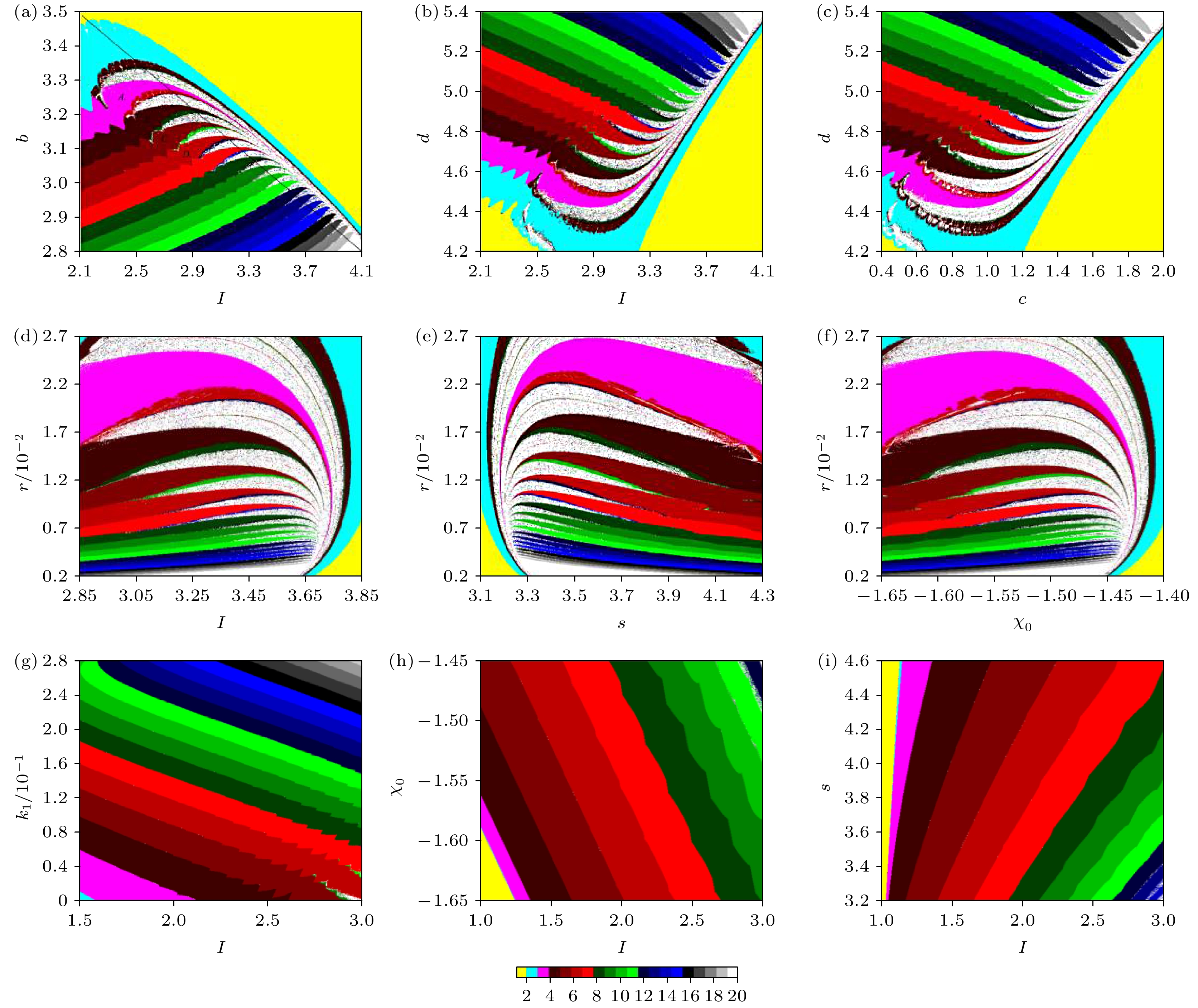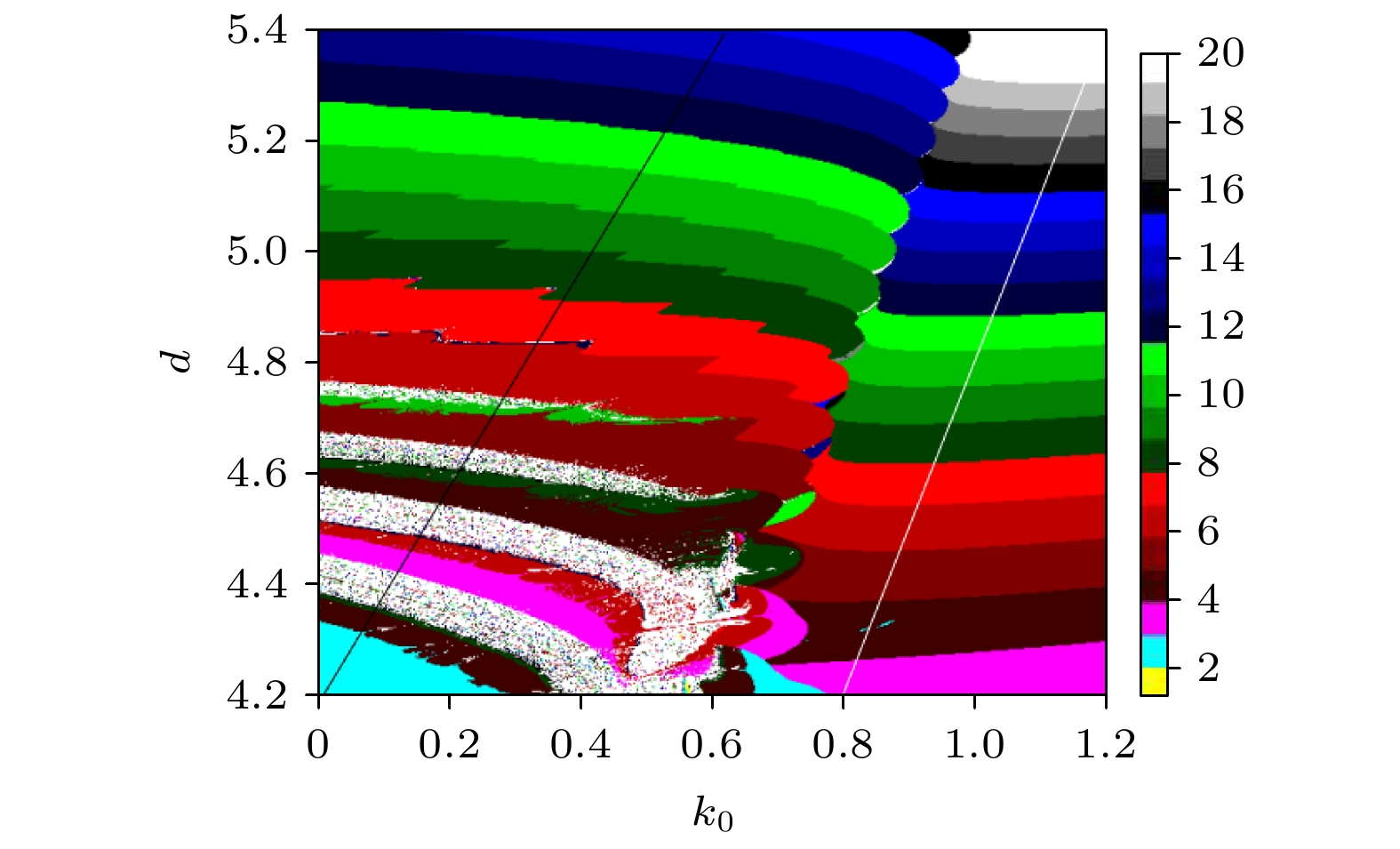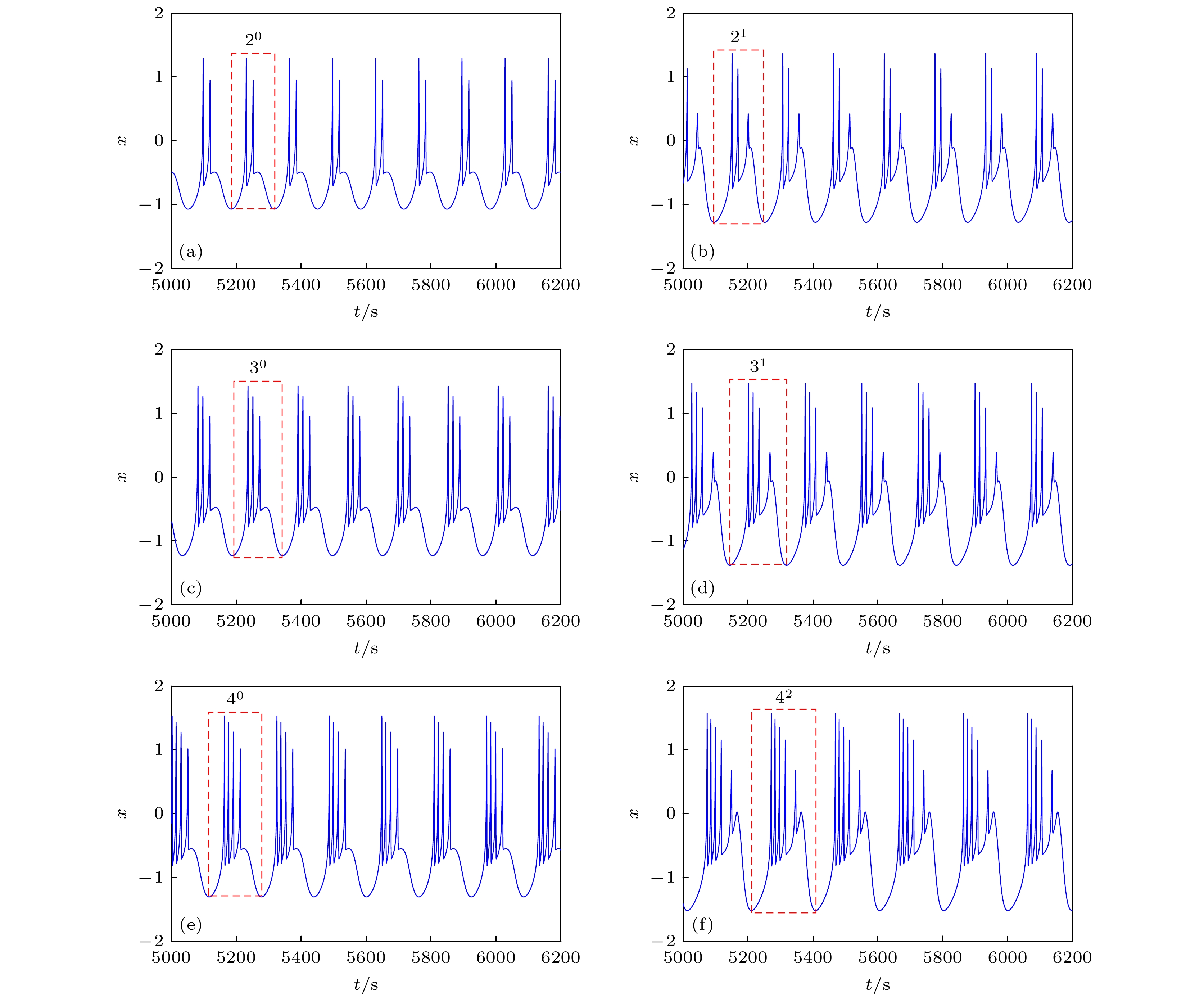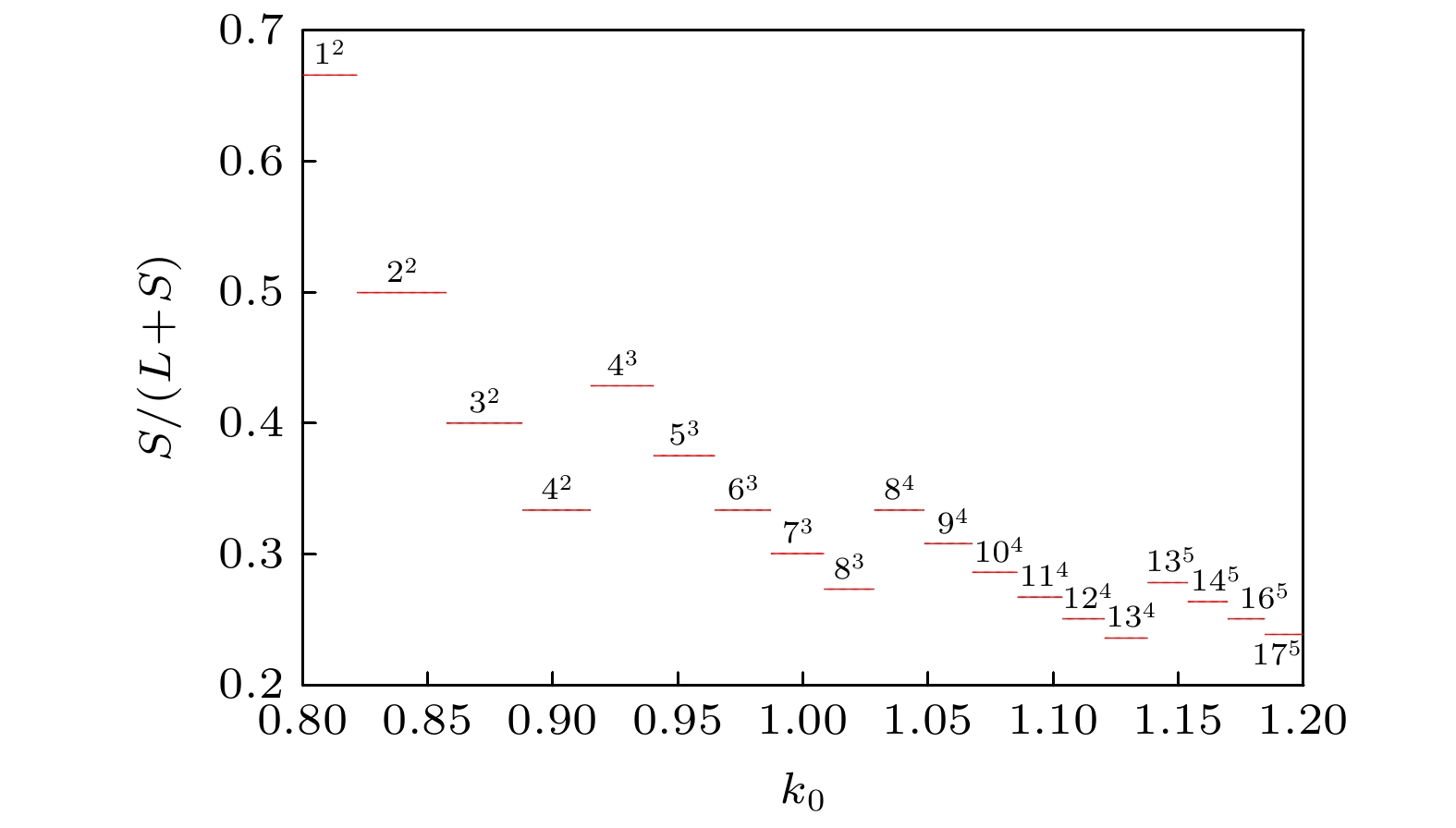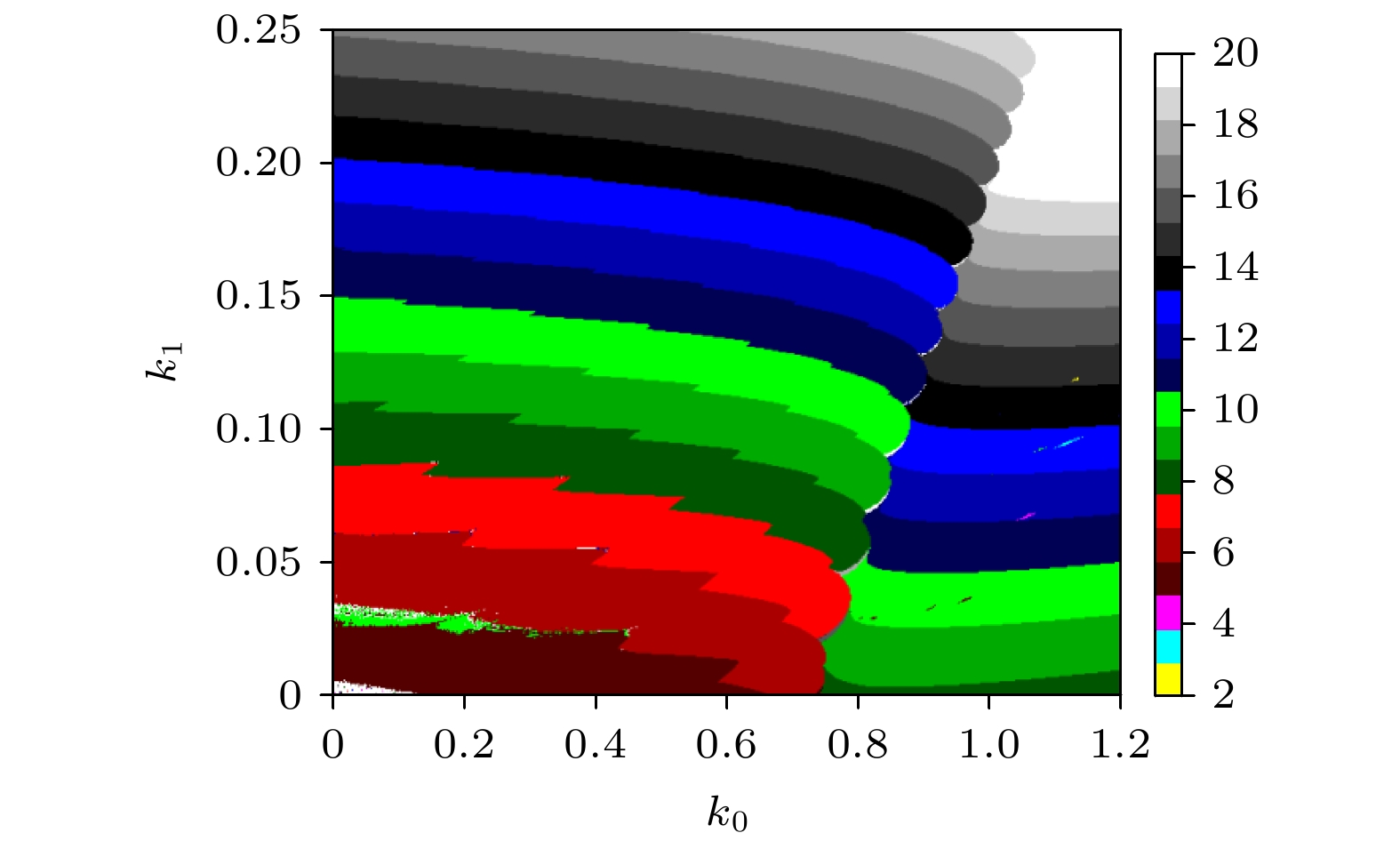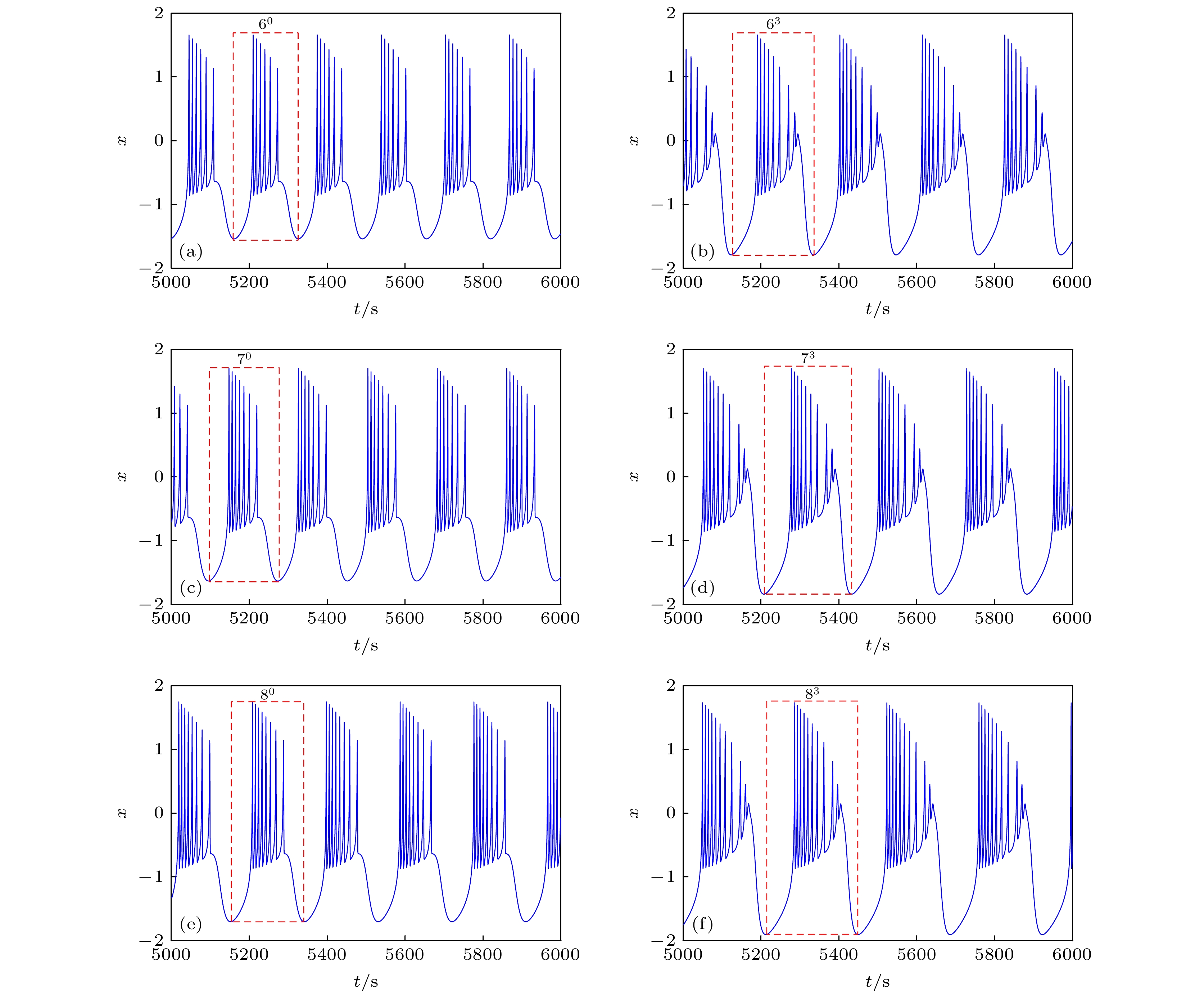-
The time-varying electric fields generated by continuously pumping and transmitting calcium, potassium and sodium ions in cells not only affect the discharge activity of neurons, but also induce time-varying magnetic fields to further regulate the fluctuation of ions. According to the Maxwell's electromagnetic field theory, time-varying electric field and magnetic field can stimulate each other in the electrophysiological environment inside and outside the cells to produce electromagnetic field. In order to explore the discharge rhythm transition of neurons under the influence of electromagnetic fields, a five-dimensional (5D) HR neuron model (EMFN model for short) is established by introducing magnetic flux variable and electric field variable into a three-dimensional (3D) Hindmarsh-Rose (HR) neuron model. Firstly, the equilibrium distribution and global bifurcation properties of EMFN model are analyzed by Matcont software, then the existence of subcritical Hopf bifurcation, hidden discharge, coexistence of periodic discharge and resting state are found and analyzed. Secondly, by using the tools of two-parameter and one-parameter bifurcation, ISI bifurcation and the maximum Lyapunov exponent for numerical simulation, the period-adding bifurcation with and without chaos, mixed mode discharge and coexistence mode discharge in the EMFN model are analyzed in detail. At the same time, the transition law of discharge rhythm with the influence of electric field and magnetic field intensity is revealed. Finally, the Washout controller is used to convert the subcritical Hopf bifurcation into supercritical Hopf bifurcation, so the topological structure of EMFN model near the bifurcation point is changed for eliminating the hidden discharge. The research results of this paper confirm that the novel neuron model has rich discharge rhythm, which will affect the information transmission and coding, and provide some ideas for improving the neuron models, revealing the influence of electromagnetic field on biological nervous system, and exploring the pathogenic mechanism of some neurological diseases.
-
Keywords:
- electromagnetic fields /
- Hopf bifurcation analysis /
- hidden attractor /
- two-parameter bifurcation /
- mixed mode discharge
[1] Varona P, Levi R, Arshavsky Y I, Rabinovich M I, Selverston A I 2004 Neurocomputing 58 549
 Google Scholar
Google Scholar
[2] Kato R, Yamanaka M, Kobayashi M 2018 J. Pharmacol. Sci. 136 172
 Google Scholar
Google Scholar
[3] Kayasandik C, Guo K H, Labate D 2019 J. Comput. Appl. Math. 349 482
 Google Scholar
Google Scholar
[4] 丁学利, 贾冰, 李玉叶 2019 68 180502
 Google Scholar
Google Scholar
Ding X L, Jia B, Li Y Y 2019 Acta Phys. Sin. 68 180502
 Google Scholar
Google Scholar
[5] Nielsen B F 2017 J. Math. Neurosci. 7 6
 Google Scholar
Google Scholar
[6] Shim Y, Husbands P 2018 Adapt. Behav. 26 165
 Google Scholar
Google Scholar
[7] Otsuka S, Omori T 2019 Neural Netw. 109 137
 Google Scholar
Google Scholar
[8] 杨永霞, 李玉叶, 古华光 2020 69 040501
 Google Scholar
Google Scholar
Yang Y X, Li Y Y, Gu H G 2020 Acta Phys. Sin. 69 040501
 Google Scholar
Google Scholar
[9] Hodgkin A L, Huxley A F 1952 J. Physiol. 116 473
 Google Scholar
Google Scholar
[10] Morris C, Lecar H 1981 Biophys. J. 35 193
 Google Scholar
Google Scholar
[11] Chay R T 1983 J. Phys. Chem. 87 2935
 Google Scholar
Google Scholar
[12] Hindmarsh J L, Rose R M 1984 P. Roy. Soc. B-Biol. Sci. 221 87
 Google Scholar
Google Scholar
[13] Izhikevich E M 2003 IEEE T. Neural Networ. 14 1569
 Google Scholar
Google Scholar
[14] FitzHugh R 1961 Biophys. J. 1 445
 Google Scholar
Google Scholar
[15] Cassidy A S, Merolla P, Arthur J V, Esser S K, Jackson B, Alvarez-Icaza R, Datta P, Sawada J, Wong T M, Feldman V, Amir A, Rubin D B, Akopyan F, McQuinn E, Risk W P, Modha D S 2013 The 2013 International Joint Conference on Neural Networks Dallas, USA, August 4–9, 2013 p1
[16] 徐泠风, 李传东, 陈玲 2016 65 240701
 Google Scholar
Google Scholar
Xu L F, Li C D, Chen L 2016 Acta Phys. Sin. 65 240701
 Google Scholar
Google Scholar
[17] Barrio R, Lefranc M, Martínez M A, Serrano S 2015 Europhyslett. Lett. 109 20002
 Google Scholar
Google Scholar
[18] Yang S M, Wang J, Li S, Li H Y, Wei X L, Yu H T, Deng B 2015 Neurocomputing 177 274
 Google Scholar
Google Scholar
[19] Babacan Y, Kaçar F, Gürkan K 2016 Neurocomputing 203 86
 Google Scholar
Google Scholar
[20] Bao B C, Huang A H, Bao H 2018 Complexity 2018 1
 Google Scholar
Google Scholar
[21] Usha K, Subha P A 2019 Biosystems 5 1
 Google Scholar
Google Scholar
[22] Zhao Y, Sun X Y, Liu Yang, Kurths J 2018 Nonlinear Dyn. 93 1315
 Google Scholar
Google Scholar
[23] Pham V T, Jafari S, Vaidyanathan S, Vilos C, Wang X 2016 Sci. China Technol. Sci. 59 358
 Google Scholar
Google Scholar
[24] Ma J, Tang J 2015 Sci. China Technol. Sci. 58 2038
 Google Scholar
Google Scholar
[25] Lü M, Wang C N, Ren G D, Ma J, Song X L 2016 Nonlinear Dyn. 85 1479
 Google Scholar
Google Scholar
[26] Wu F Q, Wang C N, Jin W Y Ma J 2017 Physica A 469 81
 Google Scholar
Google Scholar
[27] Kafraja M S, Parastesha F, Jafariba S 2020 Chaos, Soliton. Fract. 137 109782
 Google Scholar
Google Scholar
[28] 安新磊, 张莉 2020 力学学报 52 1174
 Google Scholar
Google Scholar
An X L, Zhang L 2020 Chin. J. Theor. Appl. Mech. 52 1174
 Google Scholar
Google Scholar
[29] Ma J, Zhang G, Hayat T, Ren G D 2019 Nonlinear Dyn. 95 1585
 Google Scholar
Google Scholar
[30] Du L, Cao Z L, Lei Y M, Deng Z C 2019 Sci. China Technol. Sci. 62 1141
 Google Scholar
Google Scholar
[31] Wang C N, Tang J, Ma J 2019 Eur. Phys. J-Spec. Top. 228 1907
 Google Scholar
Google Scholar
[32] Oliveira L B, Filanovsky I M, Allam A, Fernandes J R 2008 IEEE International Symposium on Circuits and Systems Washington, USA, May 18–21, 2008 p2322
[33] Xu Y M, Yao Z, Hobiny A, Aatef H, Ma J 2019 Front. Inform. Tech. El. 20 571
 Google Scholar
Google Scholar
[34] Ma J, Lv M, Zhou P, Xu Y, Hayat T 2017 Appl. Math. Comput. 307 321
 Google Scholar
Google Scholar
[35] Qin H L, Ma J, Ren G D, Zhou P 2018 Int J. Mod. Phys. B 32 1850298
 Google Scholar
Google Scholar
[36] An X L, Zhang L 2018 Nonlinear Dyn. 94 2995
 Google Scholar
Google Scholar
[37] Varshney V, Sabarathinam S, Prasad A 2018 Int. J. Bifurcat. Chaos 28 1850013
 Google Scholar
Google Scholar
[38] Dudkowski D, Jafari S, Kapitaniak T, Kuznetsov N, Leonov G, Prasad A 2016 Phys. Rep. 637 1
 Google Scholar
Google Scholar
[39] Gallas J A C 2015 Mod. Phys. Lett. B 29 1530018
 Google Scholar
Google Scholar
[40] Rosa L A S, Prebianca F, Hoff A, Manchein C, Albuquerque H A 2020 Int. J. Bifurcat. Chaos 30 118
 Google Scholar
Google Scholar
[41] Rao X B, Chu Y D, Chang Y X, Zhang J G, Tian Y P 2017 Nonlinear Dyn. 88 2347
 Google Scholar
Google Scholar
[42] Desroches M, Guckenheimer J, Krauskopf B, Kuehn C, Hinke M O, Wechselberger M 2012 SIAM Rev. 54 211
 Google Scholar
Google Scholar
[43] Kousaka T, Ogura Y, Shimizu K, Asahara H, Inaba N 2017 Physica D 27 48
 Google Scholar
Google Scholar
[44] Wang Q Q, Yu Y, Zhang Z D, Han X J 2019 J. Low Freq. Noise. V. A. 38 377
 Google Scholar
Google Scholar
[45] Rotstein H G 2014 Encyclopedia of Computational Neuroscience 2 1
 Google Scholar
Google Scholar
[46] 孙常春, 陈仲堂, 侯祥林 2017 振动与冲击 36 220
Sun C C, Chen Z T, Hou X L 2017 J. Vib. Shock 36 220
-
图 2 EMFN模型(2)的时间响应图和吸引子 (a)
${P_1}$ 附近的共存振荡; (b) 图(a)中蓝色放大图; (c)${P_1}$ 附近的周期2极限环; (d)${P_2}$ 附近的共存振荡; (e) 图(d)中蓝色放大图; (f)${P_2}$ 附近的周期2极限环; (g)${P_3}$ 附近的共存振荡; (h) 图(g)中蓝色放大图; (i)${P_3}$ 附近的周期1极限环Figure 2. Time responses and attractors of EMFN model (2): (a) Coexistence oscillation near
${P_1}$ ; (b) enlargement of the blue in (a); (c) limit cycle with period-2 near${P_1}$ ; (d) coexistence oscillation near${P_2}$ ; (e) enlargement of the blue in (d); (f) limit cycle with period-2 near${P_2}$ ; (g) coexistence oscillation near${P_3}$ ; (h) enlargement of the blue in (g); (i) limit cycle with period-1 near${P_3}$ .图 3 EMFN模型(2)的吸引域 (a), (c)和(e)是外界刺激电流分别取
${I_{\rm{1}}}, \;{I_2}, \;{I_3}$ 时x-y上的吸引域; (b), (d)和(f)是外界刺激电流分别取${I_{\rm{1}}}, \;{I_2}, \;{I_3}$ 时x-ϕ上的吸引域Figure 3. The attractive basins of EMFN model (2): (a), (c) and (e) are the attractive basins in x-y plane under
${I_{\rm{1}}}, \;{I_2}, \;{I_3}$ , respectively; (b), (d) and (f) are the attractive basins in x-ϕ plane under${I_{\rm{1}}}, \;{I_2}, \;{I_3}$ , respectively.图 4 EMFN模型(2)关于x的双参数分岔图 (a)
$I$ 和$b$ 对应的分岔图; (b)$I$ 和$d$ 对应的分岔图; (c)$c$ 和$d$ 对应的分岔图; (d)$I$ 和$r$ 对应的分岔图; (e)$s$ 和$r$ 对应的分岔图; (f)${\chi _0}$ 和$r$ 对应的分岔图; (g)$I$ 和${k_1}$ 对应的分岔图; (h)$I$ 和${\chi _0}$ 对应的分岔图; (i)$I$ 和$s$ 对应的分岔图Figure 4. Two-parameter bifurcation diagrams of EMFN model (2) versus x: (a) Bifurcation diagram versus
$I$ and$b$ ; (b) bifurcation diagram versus$I$ and$d$ ; (c) bifurcation diagram versus$c$ and$d$ ; (d) bifurcation diagram versus$I$ and$r$ ; (e) bifurcation diagram versus$s$ and$r$ ; (f) bifurcation diagram versus${\chi _0}$ and$r$ ; (g) bifurcation diagram versus$I$ and${k_1}$ ; (h) bifurcation diagram versus$I$ and${\chi _0}$ ; (i) bifurcation diagram versus$I$ and$s$ .图 7 EMFN模型(2)关于
$I$ 和$b$ 的时间响应图 (a)$I = 2.389, b = 3.239$ 时的周期3簇放电; (b)$I = 2.577, b = 3.173$ 时的周期4簇放电; (c)$I = 2.733, b = 3.134$ 时的周期5簇放电; (d)$I = 2.898, b = 3.093$ 时的周期6簇放电Figure 7. Time response diagram of EMFN model (2) versus
$I$ and$b$ : (a) Bursting with period-3 when$I = 2.389, b = 3.239$ ; (b) bursting with period-4 when$I = 2.577, b = 3.173$ ; (c) bursting with period-5 when$I = 2.733, b = 3.134$ ; (d) bursting with period-6 when$I = 2.898, b = 3.093$ .图 9 EMFN模型(2)的时间响应图 (a) 周期2放电; (b) 周期
${2^1}$ 放电; (c) 周期3放电; (d) 周期${3^1}$ 放电; (e) 周期4放电; (f) 周期${{\rm{4}}^{\rm{2}}}$ 放电Figure 9. Time response diagrams of EMFN model (2): (a) Discharge with period-2; (b) discharge with period-
${2^1}$ ; (c) discharge with period-3; (d) discharge with period-${3^1}$ ; (e) discharge with period-4; (f) discharge with period-${4^2}$ .图 10 EMFN模型(2)的共存吸引域 (a)
$({k_0}, d) = (0.6587, 4.2596)$ 时关于x-ϕ的吸引域; (b)$({k_0}, d) = (0.6587, 4.2596)$ 时关于x-E的吸引域; (c)$({k_0}, d) = (0.7032, 4.3758)$ 时关于x-ϕ的吸引域; (d)$({k_0}, d) = (0.7032, 4.3758)$ 时关x-E于的吸引域; (e)$({k_0}, d) = (0.7{\rm{123}}, 4.{\rm{5032}})$ 时关于x-ϕ的吸引域; (f)$({k_0}, d) = (0.7{\rm{123}}, 4.{\rm{5032}})$ 时关于x-E的吸引域Figure 10. The coexisting attraction domains of EMFN model (2): (a) Attractive basins of x-ϕ plane when
$({k_0}, d) = (0.6587, 4.2596)$ ; (b) attractive basins of x-E plane when$({k_0}, d) = (0.6587, 4.2596)$ ; (c) attractive basins of x-ϕ plane when$({k_0}, d) = (0.7032, 4.3758)$ ; (d) attractive basins of x-E plane when$({k_0}, d) = (0.7032, 4.3758)$ ; (e) attractive basins of x-ϕ plane when$({k_0}, d) = (0.7123, 4.5032)$ ; (f) attractive basins of x-E plane when$({k_0}, d) = (0.7123, 4.5032)$ .图 15 EMFN模型(2)的时间响应图 (a) 周期6放电; (b) 周期
${6^3}$ 放电; (c) 周期7放电; (d) 周期${7^3}$ 放电; (e) 周期8放电; (f) 周期${8^3}$ 放电Figure 15. Time response diagrams of EMFN model (2): (a) Discharge with period-6; (b) discharge with period-
${6^3}$ ; (c) discharge with period-7; (d) discharge with period-${7^3}$ ; (e) discharge with period-8; (f) discharge with period-${8^3}$ .图 21 反馈增益
$m$ 对受控系统(7)的放电影响 (a) 当$I = {I_2}$ 时, 受控系统(7)放电演化图; (b) 当$I = {I_3}$ 时, 受控系统(7)放电演化图Figure 21. The discharge influence of feedback gain
$m$ to controlled system (7): (a) Discharge evolution of the controlled system (7) when$I = {I_2}$ ; (b) Discharge evolution of the controlled system (7) when$I = {I_3}$ . -
[1] Varona P, Levi R, Arshavsky Y I, Rabinovich M I, Selverston A I 2004 Neurocomputing 58 549
 Google Scholar
Google Scholar
[2] Kato R, Yamanaka M, Kobayashi M 2018 J. Pharmacol. Sci. 136 172
 Google Scholar
Google Scholar
[3] Kayasandik C, Guo K H, Labate D 2019 J. Comput. Appl. Math. 349 482
 Google Scholar
Google Scholar
[4] 丁学利, 贾冰, 李玉叶 2019 68 180502
 Google Scholar
Google Scholar
Ding X L, Jia B, Li Y Y 2019 Acta Phys. Sin. 68 180502
 Google Scholar
Google Scholar
[5] Nielsen B F 2017 J. Math. Neurosci. 7 6
 Google Scholar
Google Scholar
[6] Shim Y, Husbands P 2018 Adapt. Behav. 26 165
 Google Scholar
Google Scholar
[7] Otsuka S, Omori T 2019 Neural Netw. 109 137
 Google Scholar
Google Scholar
[8] 杨永霞, 李玉叶, 古华光 2020 69 040501
 Google Scholar
Google Scholar
Yang Y X, Li Y Y, Gu H G 2020 Acta Phys. Sin. 69 040501
 Google Scholar
Google Scholar
[9] Hodgkin A L, Huxley A F 1952 J. Physiol. 116 473
 Google Scholar
Google Scholar
[10] Morris C, Lecar H 1981 Biophys. J. 35 193
 Google Scholar
Google Scholar
[11] Chay R T 1983 J. Phys. Chem. 87 2935
 Google Scholar
Google Scholar
[12] Hindmarsh J L, Rose R M 1984 P. Roy. Soc. B-Biol. Sci. 221 87
 Google Scholar
Google Scholar
[13] Izhikevich E M 2003 IEEE T. Neural Networ. 14 1569
 Google Scholar
Google Scholar
[14] FitzHugh R 1961 Biophys. J. 1 445
 Google Scholar
Google Scholar
[15] Cassidy A S, Merolla P, Arthur J V, Esser S K, Jackson B, Alvarez-Icaza R, Datta P, Sawada J, Wong T M, Feldman V, Amir A, Rubin D B, Akopyan F, McQuinn E, Risk W P, Modha D S 2013 The 2013 International Joint Conference on Neural Networks Dallas, USA, August 4–9, 2013 p1
[16] 徐泠风, 李传东, 陈玲 2016 65 240701
 Google Scholar
Google Scholar
Xu L F, Li C D, Chen L 2016 Acta Phys. Sin. 65 240701
 Google Scholar
Google Scholar
[17] Barrio R, Lefranc M, Martínez M A, Serrano S 2015 Europhyslett. Lett. 109 20002
 Google Scholar
Google Scholar
[18] Yang S M, Wang J, Li S, Li H Y, Wei X L, Yu H T, Deng B 2015 Neurocomputing 177 274
 Google Scholar
Google Scholar
[19] Babacan Y, Kaçar F, Gürkan K 2016 Neurocomputing 203 86
 Google Scholar
Google Scholar
[20] Bao B C, Huang A H, Bao H 2018 Complexity 2018 1
 Google Scholar
Google Scholar
[21] Usha K, Subha P A 2019 Biosystems 5 1
 Google Scholar
Google Scholar
[22] Zhao Y, Sun X Y, Liu Yang, Kurths J 2018 Nonlinear Dyn. 93 1315
 Google Scholar
Google Scholar
[23] Pham V T, Jafari S, Vaidyanathan S, Vilos C, Wang X 2016 Sci. China Technol. Sci. 59 358
 Google Scholar
Google Scholar
[24] Ma J, Tang J 2015 Sci. China Technol. Sci. 58 2038
 Google Scholar
Google Scholar
[25] Lü M, Wang C N, Ren G D, Ma J, Song X L 2016 Nonlinear Dyn. 85 1479
 Google Scholar
Google Scholar
[26] Wu F Q, Wang C N, Jin W Y Ma J 2017 Physica A 469 81
 Google Scholar
Google Scholar
[27] Kafraja M S, Parastesha F, Jafariba S 2020 Chaos, Soliton. Fract. 137 109782
 Google Scholar
Google Scholar
[28] 安新磊, 张莉 2020 力学学报 52 1174
 Google Scholar
Google Scholar
An X L, Zhang L 2020 Chin. J. Theor. Appl. Mech. 52 1174
 Google Scholar
Google Scholar
[29] Ma J, Zhang G, Hayat T, Ren G D 2019 Nonlinear Dyn. 95 1585
 Google Scholar
Google Scholar
[30] Du L, Cao Z L, Lei Y M, Deng Z C 2019 Sci. China Technol. Sci. 62 1141
 Google Scholar
Google Scholar
[31] Wang C N, Tang J, Ma J 2019 Eur. Phys. J-Spec. Top. 228 1907
 Google Scholar
Google Scholar
[32] Oliveira L B, Filanovsky I M, Allam A, Fernandes J R 2008 IEEE International Symposium on Circuits and Systems Washington, USA, May 18–21, 2008 p2322
[33] Xu Y M, Yao Z, Hobiny A, Aatef H, Ma J 2019 Front. Inform. Tech. El. 20 571
 Google Scholar
Google Scholar
[34] Ma J, Lv M, Zhou P, Xu Y, Hayat T 2017 Appl. Math. Comput. 307 321
 Google Scholar
Google Scholar
[35] Qin H L, Ma J, Ren G D, Zhou P 2018 Int J. Mod. Phys. B 32 1850298
 Google Scholar
Google Scholar
[36] An X L, Zhang L 2018 Nonlinear Dyn. 94 2995
 Google Scholar
Google Scholar
[37] Varshney V, Sabarathinam S, Prasad A 2018 Int. J. Bifurcat. Chaos 28 1850013
 Google Scholar
Google Scholar
[38] Dudkowski D, Jafari S, Kapitaniak T, Kuznetsov N, Leonov G, Prasad A 2016 Phys. Rep. 637 1
 Google Scholar
Google Scholar
[39] Gallas J A C 2015 Mod. Phys. Lett. B 29 1530018
 Google Scholar
Google Scholar
[40] Rosa L A S, Prebianca F, Hoff A, Manchein C, Albuquerque H A 2020 Int. J. Bifurcat. Chaos 30 118
 Google Scholar
Google Scholar
[41] Rao X B, Chu Y D, Chang Y X, Zhang J G, Tian Y P 2017 Nonlinear Dyn. 88 2347
 Google Scholar
Google Scholar
[42] Desroches M, Guckenheimer J, Krauskopf B, Kuehn C, Hinke M O, Wechselberger M 2012 SIAM Rev. 54 211
 Google Scholar
Google Scholar
[43] Kousaka T, Ogura Y, Shimizu K, Asahara H, Inaba N 2017 Physica D 27 48
 Google Scholar
Google Scholar
[44] Wang Q Q, Yu Y, Zhang Z D, Han X J 2019 J. Low Freq. Noise. V. A. 38 377
 Google Scholar
Google Scholar
[45] Rotstein H G 2014 Encyclopedia of Computational Neuroscience 2 1
 Google Scholar
Google Scholar
[46] 孙常春, 陈仲堂, 侯祥林 2017 振动与冲击 36 220
Sun C C, Chen Z T, Hou X L 2017 J. Vib. Shock 36 220
Catalog
Metrics
- Abstract views: 11155
- PDF Downloads: 151
- Cited By: 0

















 DownLoad:
DownLoad:


















